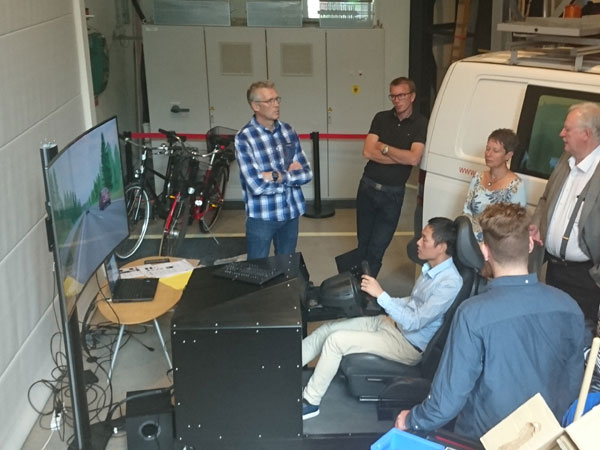Better accessibility and shorter response times for emergency vehicles – this is something that standardised, directed, traffic messages, transmitted over the 5G network can contribute. Within the EU project Nordic Way 2, a functioning prototype of such a service is being developed. This is being done with the help of driving simulators from VTI.
“Using our driving simulators already in the design and prototype phase allows us to be involved and influence the design of the system,” says Anders Lindström, Research Director at VTI and the person responsible for this part of Nordic Way 2.

Project participators from Swedish Transport Administration, Volvo AB, Volvo Cars and Carmenta are testing emergency driving at VTI, Sweden. Photo: Anders Lindström/VTI
The project, which runs until 2020, is based on hands-on collaboration on digital infrastructure between the four transport authorities in Norway, Sweden, Finland and Denmark. One of the use cases in the project involves emergency vehicles. The project will demonstrate how a standardised information message called “Emergency Vehicle Approaching” (EVA) sent over the 5G network can alert others to emergency vehicles approaching.
The warning will be received by both self-driving vehicles and other vehicles, and the message will also contain information about the planned route. In this way, the specific vehicles concerned can be reached with targeted and adapted information.
VTI’s role in the project includes using driving simulators to set requirements, design and demonstrate how such a solution would work when driving. In the simulated driving routes being developed by VTI in the project, the solution can be studied from the perspective of the emergency vehicle, surrounding vehicles and other road users. A mobile simulator is also being designed and built to be used for demonstrations and workshops. An initial prototype has already been tested by the project’s participants.
“Our hope is that in addition to improved traffic flow and shortened response times, such a warning system – if properly designed – should also lead to fewer traffic accidents. The same technology should also be able to warn about the location of accident sites and rescue operations being deployed and clearing out,” says Anders Lindström.
“It is important to avoid accidents where emergency personnel who are busy saving lives are injured themselves or in the worst case lose their lives, which unfortunately has been the case in several tragic incidents in recent years.
The connection to the emergency vehicle drivers is also very important, and in the project, VTI cooperates with emergency services, ambulance services and the police to design the best possible system.”
About Nordic Way 2
In a previous project, Nordic Way, volunteer drivers in the Nordic countries have been interconnected and have exchanged information with each other and gained access to information from authorities regarding weather conditions, road obstacles, road works and icy roads. The purpose of that project and its successor, Nordic Way 2, is to reduce the number of accidents in the short term, and contribute to better traffic flows in the long term.
Nordic Way 2 involves VTI, the Swedish Transport Administration and their Nordic counterparts, together with several companies and organisations. These include Carmenta, Ericsson, Volvo AB, Volvo Cars, Zenuity, Swarco, SWECO, MSB and others.
Nordic Way is part of the EU programme CEF – Connecting European Facility, which supports the implementation of major road and rail projects. The main parties in the project are the transport authorities in Denmark, Finland, Norway and Sweden.
 Contact:
Contact:
Anders Lindström
anders.lindstrom@vti.se
VTI, Sweden






Follow us: